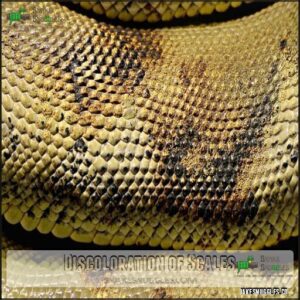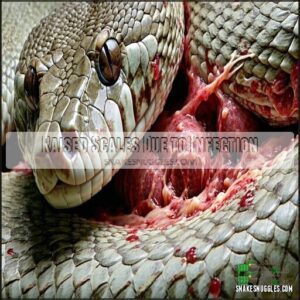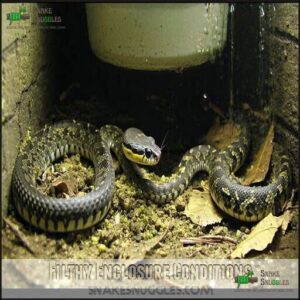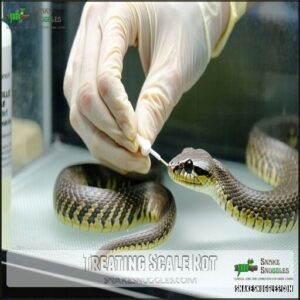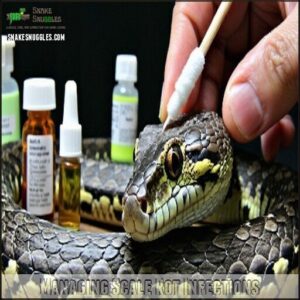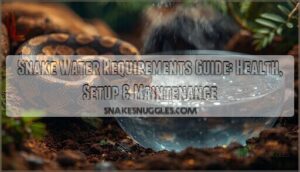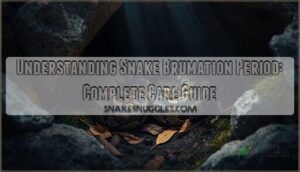This site is supported by our readers. We may earn a commission, at no cost to you, if you purchase through links.
 To treat scale rot in snakes, you’ll need to address the infection promptly.
To treat scale rot in snakes, you’ll need to address the infection promptly.
Clean the affected area with diluted betadine solution (1:10 ratio), gently pat dry, and apply a reptile-safe antibiotic ointment.
Improve enclosure conditions immediately by reducing humidity, cleaning thoroughly, and replacing substrate.
For severe cases with blisters or tissue damage, you’ll need vet assistance for prescription antibiotics.
Daily treatment is necessary until scales look normal again, typically 7-14 days.
Remember, treating scale rot isn’t just about medication—fixing your snake’s environment is like giving your scaly friend a health insurance policy that actually works, and it’s crucial to address the infection promptly, reduce humidity, and provide reptile-safe care.
Table Of Contents
- Key Takeaways
- Identifying Scale Rot
- Causes of Scale Rot
- Symptoms of Scale Rot
- Treating Scale Rot
- Preventing Scale Rot
- Managing Scale Rot Infections
- Frequently Asked Questions (FAQs)
- What should I do if my snake has scale rot?
- How do you treat scale rot in reptiles?
- How do you treat corn snake scale rot?
- Can I give my snake antibiotic ointment for scale rot?
- How do you get rid of snake scales?
- How do you get rid of scale rot on snakes?
- Is scale rot bad for snakes?
- Can I use iodine for scale rot?
- Is scale rot an emergency?
- Is scale rot contagious to other reptiles?
- Conclusion
Key Takeaways
- You’ll need to act quickly by cleaning affected areas with diluted betadine solution (1:10 ratio) and applying reptile-safe antibiotic ointment to effectively treat scale rot in your snake.
- You must address the root causes by improving enclosure conditions, reducing humidity, replacing substrate, and maintaining proper temperature regulation to prevent reinfection.
- You can identify scale rot by watching for discoloration on scales (brown, red, or greenish-black patches), raised scales, fluid-filled blisters, or raw areas that indicate infection.
- You should quarantine an infected snake immediately, maintain daily treatment for 7-14 days, and seek veterinary assistance for severe cases with blisters or tissue damage that require prescription antibiotics.
Identifying Scale Rot
To identify scale rot in your snake, watch for discoloration on the scales, like brown, red, or greenish-black patches.
Look closely for raised scales, fluid-filled blisters, or raw, ulcerated areas that may signal infection.
Discoloration of Scales
When spotting snake scale rot, look for discolored scales on the belly or areas touching the substrate.
These patches may appear yellow, brown, red, or greenish-black. Discoloration indicates early scale rot symptoms, highlighting affected areas.
Identifying colors helps assess severity levels and underlying causes.
Prompt action, including preventative measures, can stop snake skin damage from worsening and protect your reptile’s health.
Pus-Filled Blisters
Pus-filled blisters are a telltale sign of snake scale rot. These snake scale blisters usually develop on areas in contact with damp substrate.
Watch for these key changes:
- Fluid appears clear or yellow, indicating bacteria.
- Ruptured blisters may ooze pus.
- Infection severity increases if untreated.
- Early treatment options include cleaning and topical antibiotics.
Fluid analysis helps in understanding the bacterial infection. Early detection is crucial for effective treatment, and prompt action can prevent further complications.
Raised Scales Due to Infection
Raised scales are an early warning sign of a worsening snake scale infection. Often, blood pooling causes this scale elevation, making the skin feel oddly bumpy.
It’s like touching a loose puzzle piece. Identifying the underlying causes, like snake scale rot, early can help pinpoint treatment options before infection severity increases.
| Cause | Symptom Detected | Outcome |
|---|---|---|
| Blood pooling | Raised scales | Swollen or elevated skin |
| Damp substrate | Infection severity | Increased bacterial spread |
| Poor shedding | Scale elevation | Increased vulnerability |
The table outlines the relationship between causes, symptoms, and outcomes of snake scale issues, highlighting the importance of early detection and treatment to prevent infection severity from increasing.
Skin Lesions and Ulcers
When raised scales worsen, skin lesions and ulcers may appear, signaling advanced snake scale rot. These sores expose raw tissue, increasing the risk of secondary infections.
Watch for:
- Red, open wounds near the belly or cloacal area.
- Ulcer progression with oozing fluid.
- Lesion severity worsening after shedding.
- Darkened, soft tissue prone to tearing.
- Scarring effects during delayed healing stages.
It is crucial to monitor these signs closely to prevent further complications, as they can lead to more severe health issues, including secondary infections.
Causes of Scale Rot
Scale rot happens when poor husbandry weakens your snake’s natural defenses, allowing bacteria to invade damaged skin.
High humidity, improper temperatures, filthy enclosures, or scale injuries can all create the perfect conditions for infection.
Elevated Humidity Levels
Humidity impacts your snake’s health substantially.
Excessive humidity makes the substrate damp, fostering bacterial growth and risking bacterial infection.
High humidity can also cause shedding problems, leading to retained skin that traps bacteria.
This creates a perfect storm for snake scale rot causes, especially on the belly.
Inadequate ventilation exacerbates this issue.
Poor snake hygiene in a humid snake enclosure may even trigger respiratory issues.
Insufficient Temperature Regulation
Inconsistent snake temperature regulation can trigger scale rot.
Without proper basking spot heat and nighttime temperatures, a snake’s immune system weakens.
Thermostat failures or poor heating element choice lead to dangerous drops or spikes.
Use reliable thermometers to monitor temperature gradients.
Remember, a stable snake enclosure keeps your pet comfortable and prevents high snake humidity, which fosters bacteria growth.
Filthy Enclosure Conditions
A dirty cage leads to bacteria growth, causing risk for scale rot.
Fecal buildup, uneaten prey, and shedding issues create the perfect breeding ground for infections.
Poor substrate choice worsens the problem by trapping moisture.
Prioritize snake enclosure cleaning to maintain hygiene.
Regular enclosure cleaning helps eliminate harmful bacteria and keeps your snake healthy.
Remember, a clean home means a healthy snake!
Trauma to Scales
Skin damage isn’t just from dirty enclosures; think of it like a snake’s version of a scraped knee.
Trauma happens when scales meet trouble, such as:
- Prey injuries: Live prey can bite back.
- Sharp objects: Decorations can create skin damage.
- Handling damage: Rough handling causes snake wounds.
- Shedding issues: Retained scales invite infection.
Keep environments safe and hazard-free.
Symptoms of Scale Rot
When your snake has scale rot, you’ll notice visible signs like discolored belly scales or pus-filled blisters.
Raised scales, ulcers, and even loss of appetite can indicate that the infection has progressed.
Discoloration of Ventral Scales
Discoloration on a snake’s ventral scales is an early sign of scale rot. Affected areas often show greenish-black, red, yellow, or brown hues, indicating scale rot symptoms.
Recognizing patterns, like darkened spots or irregular patches, helps assess snake scale discoloration. Monitor scale appearance closely to spot these snake skin problems early. Pay attention to severity levels—mild changes can worsen without treatment.
Blisters Filled With Pus
While discolored scales mark early signs of trouble, pus-filled blisters represent a concerning progression of scale rot.
Pus-filled blisters signal an alarming advancement of scale rot, demanding immediate attention to prevent infection from worsening.
You’ll notice these fluid-filled pouches developing primarily on scales that contact the substrate.
Initially clear or yellowish in composition, these blisters indicate an active bacterial infection in your snake.
As the infection stage advances, they may become increasingly opaque and swollen, suggesting higher blister severity.
Without proper scale rot treatment, these pouches risk rupture, allowing the infection to spread further.
Raised Scales With Blood Pooling
Looking closely at your snake’s scales can reveal another concerning symptom: raised scales with blood pooling underneath.
This happens when bacterial infections cause blood to accumulate beneath the scales, creating a puffy, elevated appearance that you can feel when gently touching your pet. Early detection is essential for effective treatment.
- Blood pooling often appears as red or dark patches under transparent scales
- Severity increases with the amount of elevation – higher scales indicate worse infections
- Scales may feel soft or spongy when gently pressed
- Most commonly affects belly (ventral) scales that contact substrate
- Treatment options depend on how much blood has accumulated
For more information on treating scale rot, visit the Early detection page, which provides effective treatment options and guidance on managing bacterial infections.
Loss of Appetite
During the progression of scale rot, you’ll often notice your snake exhibiting loss of appetite.
This appetite decline isn’t just picky eating—it’s your reptile’s response to infection-related discomfort.
When fighting scale rot, snakes typically refuse food to conserve energy for healing.
Monitor this closely, as prolonged fasting requires veterinary consultation.
Never attempt force feeding without professional guidance.
Instead, focus on treating the infection first, then nutritional support will follow during recovery feeding.
Treating Scale Rot
You’ll need to act quickly when treating scale rot in your snake, starting with quarantine and gentle daily cleaning of affected areas with chlorhexidine or diluted betadine solution.
After cleaning, you should apply an antibiotic ointment without pain relievers and maintain proper humidity levels in a clean enclosure to promote healing.
Quarantine and Isolation
The first critical step in treating scale rot is immediate quarantine of your infected snake. You’ll need to isolate it in a separate enclosure to prevent spread to other reptiles and create ideal healing conditions.
A key indicator is discoloration of scales, so be vigilant.
To ensure proper care, follow these steps:
- Use paper towel substrate for easy cleaning and monitoring
- Maintain strict hygiene protocols between handling infected and healthy snakes
- Minimize contact to reduce stress during recovery
- Keep quarantine temperatures slightly higher (82-85°F) to boost immune response and support healing.
Cleaning The Affected Area
Proper cleaning of infected areas is essential for treating scale rot in snakes.
You’ll need to clean affected scales twice daily using appropriate antiseptic solutions like chlorhexidine or diluted betadine (1:3 ratio). Gently wipe each affected area with a cotton swab, removing any debris or discharge.
This cleaning frequency helps prevent re-infection while promoting healing. Always use safe products designed for reptile wound care, avoiding harsh disinfectants that could further irritate damaged scales.
Consider using a suitable antiseptic solution for superior results, and ensure to follow the instructions carefully to achieve the best outcome with proper cleaning.
Applying Antibiotic Ointment
After cleaning the affected area, apply a suitable antibiotic ointment to your snake’s infected scales.
Choose products without pain relievers, as these can harm reptiles. Apply the ointment 3-4 times daily after gently drying the area.
Triple antibiotic ointment works well for potential infections, but avoid oil-based products that cause scales to flake.
Many owners buy reptile-safe ointments online.
Continue treatment until all infected scales have shed.
Soaking in Betadine Solution
For treating scale rot, prepare a diluted betadine solution by mixing one part 10% Povidone-Iodine with ten parts lukewarm water (80-85°F), achieving a weak tea color.
The weak tea-colored betadine solution becomes your snake’s healing bath—gentle yet powerful against scale rot.
Soak your snake for 10-30 minutes daily, allowing it 5 minutes to drink first.
After soaking, gently dry with paper towels and return to a clean enclosure.
Continue treatments every 2-3 days until the infection improves, following the daily treatment routine consistently.
Preventing Scale Rot
You can prevent scale rot in your snake by maintaining proper humidity levels, regular enclosure cleaning, appropriate temperature regulation, and prompt removal of waste or uneaten food.
Regular health checks of your snake’s ventral scales will help you catch early signs of infection, allowing for immediate intervention before minor issues develop into serious health problems, which is crucial for preventing serious health problems.
Maintaining Proper Enclosure Hygiene
Keeping your snake’s home spotless is like giving them a shield against scale rot.
A clean enclosure prevents harmful bacteria from thriving and infecting your pet.
- Remove waste daily, paying special attention to feces and uneaten prey that quickly harbor bacteria
- Choose the right substrate for your species, avoiding materials that retain excessive moisture
- Establish a weekly sanitization schedule using reptile-safe disinfectants for thorough cage hygiene.
Consider optimal humidity levels to further prevent scale rot, and remember that a clean environment is key to preventing harmful bacteria and scale rot.
Regulating Humidity and Temperature
In terms of preventing scale rot, achieving the right balance with humidity and temperature is vital.
You’ll need to monitor humidity levels (35-60% for most species) and create proper temperature gradients with designated basking spots (85-95°F).
Install a reliable thermostat to maintain consistent conditions, and make seasonal adjustments as needed.
Remember, improper humidity control is like inviting bacteria to a feast in your snake’s enclosure, which can lead to serious health issues due to improper humidity.
Providing a Clean Substrate
The foundation of scale rot prevention lies in proper substrate management for your snake’s enclosure. Clean substrate prevents harmful bacteria that cause infections.
Follow these key practices:
- Replace substrate completely every 4-6 weeks
- Perform daily spot cleaning to remove waste and soiled areas
- Maintain appropriate substrate depth (1-2 inches) to prevent moisture buildup
Selecting the correct snake bedding is essential for preventing scale rot. Proper substrate management and choosing the right materials, such as paper towels or reptile carpet, often make better choices than wood shavings for snakes prone to scale issues.
Monitoring for Signs of Infection
Before scale rot becomes severe, check your snake daily for signs of infection.
Regular monitoring helps catch problems early when they’re easier to treat.
| Warning Sign | What to Look For |
|---|---|
| Behavioral Changes | Hiding more, restlessness, irritability |
| Appetite Loss | Refusing meals, lower interest in food |
| Shedding Issues | Incomplete shedding, retained eye caps |
| Activity Levels | Decreased movement, unusual positions |
| Respiratory Signs | Wheezing, bubbles around nostrils |
Watch for discoloration or blisters—these snake scale rot symptoms need immediate attention. Regular monitoring is crucial for the early detection of scale rot.
Managing Scale Rot Infections
Once you’ve identified scale rot in your snake, you’ll need to act quickly with appropriate treatment to prevent the infection from spreading and becoming life-threatening.
You can treat mild cases at home using antimicrobial solutions and antibiotic ointments, but don’t hesitate to consult a reptile veterinarian if you notice worsening symptoms or if the infection appears severe.
Recognizing Severe Infections
Now that your prevention measures are in place, you’ll need to watch for signs that indicate a severe scale rot infection requiring immediate attention.
Severe infections can progress rapidly to dangerous conditions like septicemia (blood poisoning).
Here are three critical warning signs of life-threatening complications:
- Deep tissue damage extending beyond surface scales
- Appetite loss combined with unusual lethargy onset
- Fluid-filled blisters that have ruptured or grown substantially
Don’t ignore these snake scale rot severity indicators—untreated progression can quickly become fatal.
Consulting a Veterinarian
When severe scale rot appears, it’s time to get professional help.
You’ll need a veterinarian’s expertise for advanced infections that don’t respond to home treatment.
| When to Consult | Signs of Urgency | Veterinary Care Options |
|---|---|---|
| After 5-7 days of no improvement | Spreading infection | Prescribed antibiotics |
| Deep ulcerations present | Snake stops eating | Professional debridement |
| Signs of septicemia | Discolored blood | Post-treatment monitoring |
Remember, antibiotic resistance can develop if you delay proper veterinary consultation for your snake’s scale rot diagnosis, which may lead to severe consequences and require urgent care.
Using Antimicrobial Sprays and Solutions
Apply antimicrobial sprays and solutions to fight scale rot infections effectively. These treatments reduce bacterial populations without damaging healthy tissue.
- PetSilver’s Reptile Wound Spray gives your slithery friend quick relief from painful infections
- Chlorhexidine solution creates a protective barrier against harmful bacteria, like a shield for your snake’s delicate scales
- Betadine baths offer a comforting soak that works wonders on stubborn infections
Spray affected areas 3-4 times daily, maintaining consistent treatment frequency to prevent bacterial resistance.
Promoting Healing and Recovery
The road to recovery requires consistent wound care and monitoring of healing progress.
Apply antibiotic ointment daily until scales show improvement. Boost your snake’s immune system with nutritional support through properly sized prey items.
Reduce stress by minimizing handling and maintaining ideal enclosure conditions. Consider probiotics use to support gut health during antibiotics treatment.
Document changes with photos to track progress and prevent scarring through proper humidity management and ensure the snake receives the necessary care for optimal healing with consistent wound care.
Frequently Asked Questions (FAQs)
What should I do if my snake has scale rot?
An ounce of prevention is worth a pound of cure.
Quarantine your snake, clean affected areas twice daily with betadine solution, apply antibiotic ointment, and use paper towels as substrate.
Consult a vet for severe cases.
How do you treat scale rot in reptiles?
Quarantine your reptile, replace substrate with paper towels.
Clean affected areas twice daily with betadine solution, apply antibiotic ointment without pain relief.
Most infections heal within 3-6 weeks, and for severe cases, consult a vet.
How do you treat corn snake scale rot?
To treat corn snake scale rot, isolate your snake with paper towel substrate.
Clean affected areas twice daily with diluted betadine, apply antibiotic ointment.
Seek veterinary care for severe cases.
Can I give my snake antibiotic ointment for scale rot?
Just what your slithery friend needs – medicine from the human world.
Yes, you can use triple antibiotic ointment without pain relief.
Apply it after cleaning the affected areas with betadine or chlorhexidine solution.
How do you get rid of snake scales?
Healthy snakes naturally shed their skin.
You shouldn’t remove scales yourself as this causes pain and infection.
If treating scale rot, clean affected areas with betadine solution and apply antibiotic ointment without pain relievers.
How do you get rid of scale rot on snakes?
To tackle scale rot, start by cleaning the affected area with antiseptic solutions like chlorhexidine.
Use diluted betadine soaks, apply antibiotic ointments without painkillers, and improve enclosure hygiene.
For severe cases, consult a vet promptly.
Is scale rot bad for snakes?
Like a wildfire that can devastate a forest, scale rot is extremely dangerous for your snake.
It’s a bacterial infection that can quickly progress to septicemia if left untreated, potentially killing your pet within days, which is a bacterial infection.
Can I use iodine for scale rot?
Yes, you can use diluted iodine (betadine) for treating scale rot.
Mix it in a 1:3 or 1:10 ratio with water for soaking affected areas twice daily.
It’s effective for disinfecting infected scales.
Is scale rot an emergency?
Just as you wouldn’t ignore a growing fire, you shouldn’t delay with scale rot.
It’s not an immediate emergency in early stages, but can quickly become life-threatening if left untreated, potentially causing septicemia.
Is scale rot contagious to other reptiles?
Scale rot is contagious between reptiles.
You’ll need to isolate your infected snake from other reptiles to prevent spreading the bacterial infection.
Thorough cleaning of shared equipment and enclosures helps minimize transmission risk.
Conclusion
Ever wondered how much faster your snake could recover with proper care?
By promptly recognizing symptoms and following the right treatment protocol, you’ll dramatically increase your pet’s chances of recovery.
Treating scale rot in snakes requires consistency, preventative measures, and sometimes veterinary intervention.
Remember, your vigilance is your reptile’s best defense—clean habitat, proper humidity levels, and regular health checks will guarantee your slithery companion stays scale-rot free for years to come.
Don’t wait until it’s too late!

